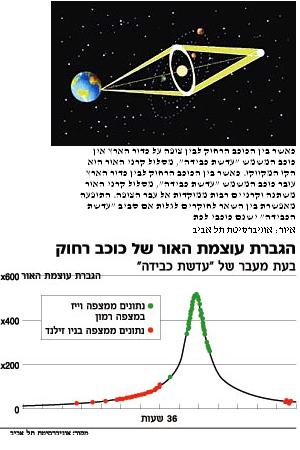The search for planets outside the solar system has so far been limited to large planets. A new method makes it possible to identify planets similar to Earth
Eran Ofek

Direct link to this page: https://www.hayadan.org.il/ofek020904.html
A fundamental condition for the existence of life outside the Earth is the existence of "Earth-like" planets around other stars (an Earth-like planet is a planet whose size and distance from its parent star are similar to the size of the Earth and its distance from the Sun). In an article published at the end of last week in the journal "Science", an international group of astronomers, who used telescopes located in Israel, Chile and New Zealand, demonstrated the effectiveness of a method known as "gravitational dusting" for discovering Earth-like planets. The decisive part of the observations was made by members of the Israeli team - including Prof. Dan Maoz and the doctoral student Yiftah Lipkin from Tel Aviv University - at the Weiss Observatory near Mitzpe Ramon. The results, presented in the article, indicate that if terrestrial planets exist around other stars, they will be discovered in the coming years.
In the last decade, astronomers have managed to discover more than a hundred planets orbiting stars outside our solar system. The vast majority of these planets have been found by measuring slight changes in the speed of the stars they orbit.
The changes in speed are caused by the effect of the planet's gravity on the star it orbits. Although the planet is small compared to the star, and therefore the gravitational force it exerts is relatively small, but this is enough to cause a vibration in the movement of the star. The disadvantage of this method today is that it allows finding only giant planets, which are only about the same as the planet Jupiter (300 times the mass of the Earth). On the other hand, the gravitational priming method is also sensitive to terrestrial planets.
The theory of general relativity indicates that when light from a distant source passes on its way near a large mass, for example a star, the path of the light rays will be bent. The movement of light rays in curved paths was predicted by Einstein as early as 1915, and the phenomenon was given the name "gravitational lensing" due to the similarity between it and what happens when light rays hit the lens. The phenomenon of the bending of light rays has been observed and measured in a variety of astronomical phenomena. The first time the phenomenon was observed, in 1919, two British expeditions went to Africa and South America to observe a total solar eclipse. The expeditions measured the position of stars near the Sun's disk and showed that when the Sun is between the stars and the Earth, the position of the stars appears slightly different from their true position.
Shifting the trajectory of the light rays coming from a distant star, due to the passage of an object that serves as a "gravitational lens" between it and the observer on Earth, means that the amount of light rays reaching the observer increases and the intensity of the star's light is increased. Events of this kind are extremely rare, and at any given moment it only occurs in one out of every million stars in our galaxy.
Astronomers discover the phenomena of gravitational collapse by computer monitoring the light intensity of millions of stars. When it is discovered that the light intensity of a star is increased due to gravitational sintering, the phenomenon can be used to search for planets in the vicinity of the star acting as a gravitational lens. These planets are not visible and the intensity of their light is not increased, but their effect on the light intensity of the distant star can be measured, and relying on it one can learn not only about the existence of the planets (or non-existence) but also about their properties, such as mass and their distance from the parent star.
A study published in "Science" reports on a star whose light intensity has been increased more than 500 times due to gravitational manipulation - the largest increase ever measured. It was the enormous amplification in this event that allowed great sensitivity to the planets. Many observations at the peak of the event, made from Mitzpe Ramon, showed that the star that served as a gravitational lens was a single star with no planets surrounding it. The peak of the event occurred while it was daylight in Chile and New Zealand, and therefore the observations conducted at the Ramon observatory made it possible to rule out the existence of planets in large areas around this star.
Although gravitational field events are observed en masse, events with such a high amplification intensity are quite rare. Continuous monitoring of such events will enable an effective search for the planets orbiting them. According to Prof. Maoz, if there were Earth-like planets around the star the researchers observed, there is a high probability that they would have been discovered. The research findings, he adds, show that in the coming years it will be possible to locate terrestrial planets and determine their frequency. Moreover, the very existence of stars that do not have planets, such as the one discovered in the study, could refine our understanding of the process of planet formation around other stars.
The writer was a member of the team of researchers who published their findings in the journal "Science". The article was first published in Haaretz newspaper.
Know planets outside the solar system
https://www.hayadan.org.il/BuildaGate4/general2/data_card.php?Cat=~~~935014479~~~54&SiteName=hayadan
